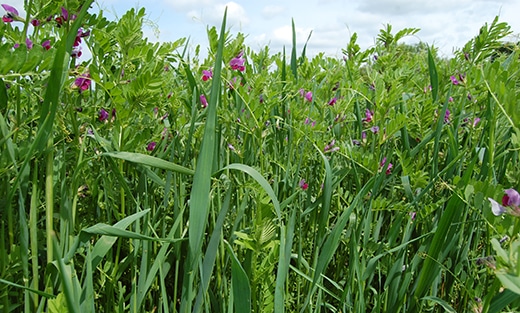Montana State University Extension is looking at both the benefits and cautions of using cover crops as partial replacement of summer fallow.
Three new bulletins and one factsheet are now available for interested producers. Information in the free publications is based on research conducted by MSU scientists and students, as well as studies done by scientists in neighboring states and Canadian provinces.
Cover crops are one tool to improve soil health and long-term agricultural sustainability, especially when grown in place of summer fallow, according to Clain Jones, co-author of the publications and Extension soil fertility specialist in the MSU Department of Land Resources and Environmental Sciences. The publications explain the benefits and cautions of using cover crops, also called covers, as partial replacement of fallow in semi-arid dryland cropping systems.
“Covers can increase plant diversity, keep the soil covered and increase the time active roots are in the soil, especially compared to fallow,” Jones said, and added that these benefits are all important to regenerate and maintain soil health.
“The main drawback of using covers in semi-arid dryland cropping systems is their use of stored soil water, which can reduce cash crop yields the following year,” Jones said.
“Cover Crops: Soil Water and Small Grain Yield and Protein” presents the results from years of regional research. Perry Miller, co-author and cropping systems professor in the Department of Land Resources and Environmental Sciences, has found early termination of covers is the key to minimizing subsequent cash crop loss due to cover crop water use.
“Cash crop losses are least when legume covers – such as pea or lentil – are terminated by first bloom, and grasses are terminated around the time heads emerge from the sheath,” said Miller.
Covers are often grown to increase soil health, Miller added, and soil organic matter contributes to soil health and is directly related to plant residue.
“However, in dryland systems, the biomass or plant residue gained by letting covers grow past first bloom does not always offset the lower amount of residue produced by lower cash crop growth,” Miller said. He said covers need to be considered in the whole system, over all rotations on a field, to determine their net impact on plant residue on a given field, including potential to add nitrogen to the soil for the next crop.
“In our dry systems, it is always a balance between covers contributing plant residue and nitrogen, against the amount of water they use, which decreases cash crop yield,” Miller said.
Small grain protein is usually higher following legume covers. However, nitrogen from legume residue is often not available early enough in the growing season to benefit small grain yields, at least until legume covers (or pulse crops) have been in rotation three to four times.
Jones said it’s important to soil test for nitrate in the spring following legumes and adjust nitrogen fertilizer rates according to soil test levels.
“Cover Crops: Management for Organic Matter and Nitrogen” focuses on cover management to benefit soil nitrogen and organic matter. The authors said building soil organic matter is a slow process, but small gains in soil organic matter can lead to improvements in soil health and structure, which are important to long-term viability of farmland.
When legumes represent most of a cover mix, the accumulation of nitrogen over time in the soil allows for reduced nitrogen fertilizer rates.
“This helps reduce the risk of soil acidification caused by ammonia-based fertilizer, an increasing issue in our region,” said Jones, adding that it also helps the farmer’s bottom line.
“Cover Crops: Soil Health” presents the impact of cover crops on soil microbial activity, nutrient cycling, soil aggregation and soil surface temperature.
“In our dryland systems, mixed species covers may not be better for soil health than a diversity of cash crops planted in continuous rotation, without summer fallow,” Jones said.
For covers to be successful, Jones added, producers need to be clear on the intended goal of planting a cover, select species suitable for their environment and equipment, ensure covers have sufficient nutrients, start small and manageable, and use information from regional research and neighbors who are successful.
If covers are used as forage, the goal, management and economics change from that of covers that are not grazed or hayed.
“Although we did not include information on covers used as forage in these bulletins, many principles apply to systems that include livestock grazing or haying of covers,” Jones said.
All three bulletins and the summary MontGuide were produced through collaboration with additional co-authors Cathy Zabinski, ecology professor, and Kathrin Olson-Rutz, research associate, both in the Department of Land Resources and Environmental Sciences; and Susan Tallman, state agronomist with the USDA Natural Resources Conservation Service.
###
MSU Extension


